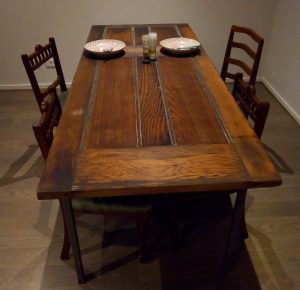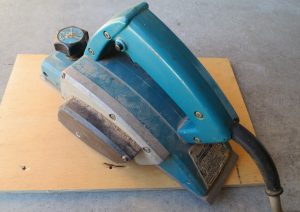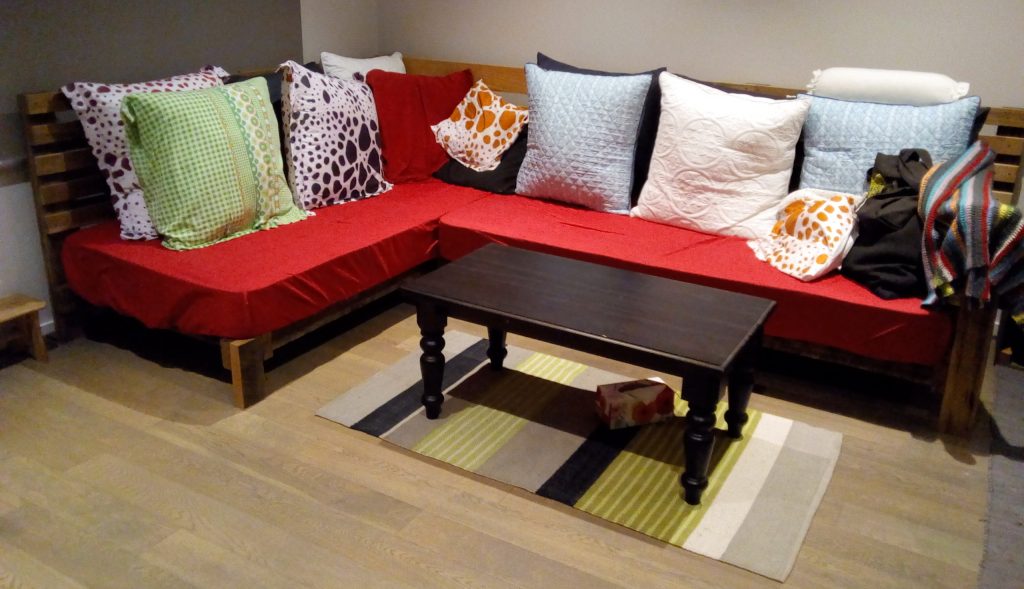What’s furniture making got to do with very smart renting? Well, for a start, it earns you valuable carpentry skills that can be used for other very smart renting projects and you can have high quality furniture that’s perfectly customised for you at a very low price.
Making our own furniture saved us $5000 compared to buying furniture of the equivalent quality. This included the cost of investing in some extra tools (which can be used in future projects) and the cost of buying fasteners and a small amount of timber.
Our furniture can be easily modified and repaired so it is unlikely that we will need to buy any replacement furniture in the future saving us even more.
Instead of making this a how to, we will talk about some of the philosophies that underpin the furniture that we made. If you can’t be bothered doing this, using second hand or pre loved furniture is also an excellent idea.
Why making your own furniture is good for you:
- A life that is a series of mini challenges is far more interesting. Think of it as a video game except that you made some real stuff better [1]. Basically, we experience “flow” when we are so engaged in an activity that we get lost in the moment.
- You gain a sense of confidence and freedom in knowing that you can cobble together anything that you need around the house.
Building your own furniture has an in built limitation, which is a good thing:
- Wood is an extremely valuable resource and when you come to appreciate how trees grow, live and die, you’ll treat it as something really special [2].
- When you build your own furniture, you are likely to finish once you have what you need and to make your designs more durable so you don’t need to make unnecessary repairs or to rebuild things again.
Use recycled timber where possible:

- It is a lot cheaper with recycled timber. We paid just $200 for the timber we used.
- It teaches you to value an important resource.
- It builds greater skills and resilience using what’s available rather than what you can buy at the hardware store.
- Recycled wood often has beautiful and random patterns in the timber that means you can easily make beautiful furniture with minimal designs.
- You can salvage good timber from friends or family in the building trades, hard rubbish or used pallets if not treated with toxic chemicals (pallets are best used outdoors though, as they can have mould issues unless properly seasoned) [3].
- Wherever you find your timber, respect the process and ask if you are unsure whether the timber is up for the taking.
- Use natural timbers as they can be burnt for firewood or composted at the end of their useful life provided that they have not been finished or treated with toxic chemicals..
- Manufactured timbers like chipboard or plywood contain toxic glues so only use them if necessary as they will go into landfill when you’re finished with them.
- If there are any signs that the wood has pests inside, it is a good use of your time and money to get your wood fumigated instead of bringing a termite or wood borer problem into your house [4].
Don’t ask, don’t get:
- It never hurts to let someone know that you are looking for a specific tool. Sometimes they may be happy to give it away or trade it for something else.
- If you’re not sure about a specific tool, you can even borrow one to see if you actually need it. Another way to get cheaper tools is to look online at second hand sites like EBay or Gumtree.

Don’t skimp on quality in the wrong areas:
- You don’t need to spend a fortune on tools but it is false economy to buy cheap tools that will break in no time or are just plain awful to use.
- Spend a little more on a good quality non-toxic wood finish. We bought a bottle of pure tung oil and a can of pure citrus solvent for $50 [5]. It is a food safe finish and it is genuinely a 100% natural product.
- Beware of some finishes marketed as “natural” products that are watered down with petro chemical solvents.
- With petro chemical solvents and finishes, you will often spend the same money because you need to use more for the job and if you want to touch up any wood in the future, you may need to sand it back first.
Keep your designs simple:
- Yes, you can use a biscuit joiner to hide the joints in your couch or you can just use nails and screws (provided that they are recessed far enough into the wood) and not worry too much.
- Just make sure that your workmanship is good enough so that no one picks up splinters, that corners are not too sharp and that the piece of furniture is strong enough to do its job.
Let your imagination run wild:
- Designing and building your own furniture means you can customise a piece of furniture exactly for your needs.
- For example, our shelf boxes are modular and save on packing when we have to move. Just tip the box on its back and it becomes a moving box; there’s no need to unpack anything.
- Our couches are designed around single bed matresses which means that we can easily clean them, fit flannel sheets to keep us warmer in the winter months and replace the matrasses without replacing the whole couch.
If all else fails, use good quality wood glue:

- We wish we could tell you that making furniture will be a walk in the park and that nothing will ever go wrong. Unfortunately, learning a hands on trade can be really tough on the ego.
- If something breaks unexpectedly, good quality wood glue will create a bond that is as strong as wood in minimal time and will not be visible.
Don’t be afraid to ask for support:
- As handy as the internet is, if you get stuck sometimes it can be loads quicker to ask someone to show you how to do something. Plus life is just nicer when it is shared with other people.
- If you haven’t worked with wood before, you will sometimes feel out of your depth so it is good to have one or two people that you can learn from if you really get stuck.
- People who are good at this are usually happy to teach you a few things as long as you show some initiative.
Remember: Safety first
- Building your own furniture doesn’t make sense if you are going to lose a finger or limb doing it. It is much more fun when you know how to do it safely.
- Ultimately, you are responsible for your safety in your home workshop.
- While writing about safety is a whole other topic (see further reading below), take your time, know how to use tools properly, know the tools you’re using and the risks they come with, wear appropriate clothing (especially not loose clothing or jewellery) and wear safety equipment when using tools [6][7].
- If you don’t know how to use a tool safely, ask someone knowledgeable (a friend, family member, local MEN’s SHED) to show you.
- If you have never used tools in your life or built anything, then it is probably better to start off with hand tools first and work your way up.
Further Reading:
[1] Chapter 17 in the Frugal Hedonist by Annie Raser-Rowland and Adam Grubb has a good overview about this.
[2] Read “The Hidden Life of Trees: What They Feel, How They Communicate” by Peter Wohlleben. You’ll never see trees in the same way again.
[3] For example, there are codes on some pallets that indicate whether they have been treated with toxic chemicals are not. Also, some pallets may have been used to carry toxic materials and could contain some of these toxins in the wood.
We picked up two pallets from a refrigerated logistics company where we know the pallets were only used to carry food. Here’s a handy list of things to consider when using pallets for furniture wood:
https://www.fix.com/blog/preparing-wood-pallets-for-upcycling/
[4] Usually a freight fowarder that deals with imported furniture will offer a fumigation service where wood or furniture items can be placed in a sealed, carbon dioxide filled chamber for 48 hours which kills all life within the wood.
This is often still cheaper than replacing affected wood with dressed timber and is the best treatment for wood or furniture that is already affected.
You can also get borax from the hardware store which prevents borers and termites from getting into the wood, though this is not effective if they are already inside and have laid eggs.
[5] http://greenhomeguide.com/know-how/article/selecting-healthy-and-environmentally-sound-finishes
[6] For example, ripping narrow boards with a mitre saw is a bad idea; your hand that holds the wood gets too close to the blade. You are better off pushing the board with a scrap piece of wood through a table saw (so your hands don’t get too close to the blade) or using a circular saw with a rip fence and the wood safely clamped down.
[7] Here’s a handy list of things to consider when using power tools. We would add to this list that when you use a power tool with a cord, make sure that the cord is safely away from the working part of the tool (e.g. the blade) to avoid cutting through it: